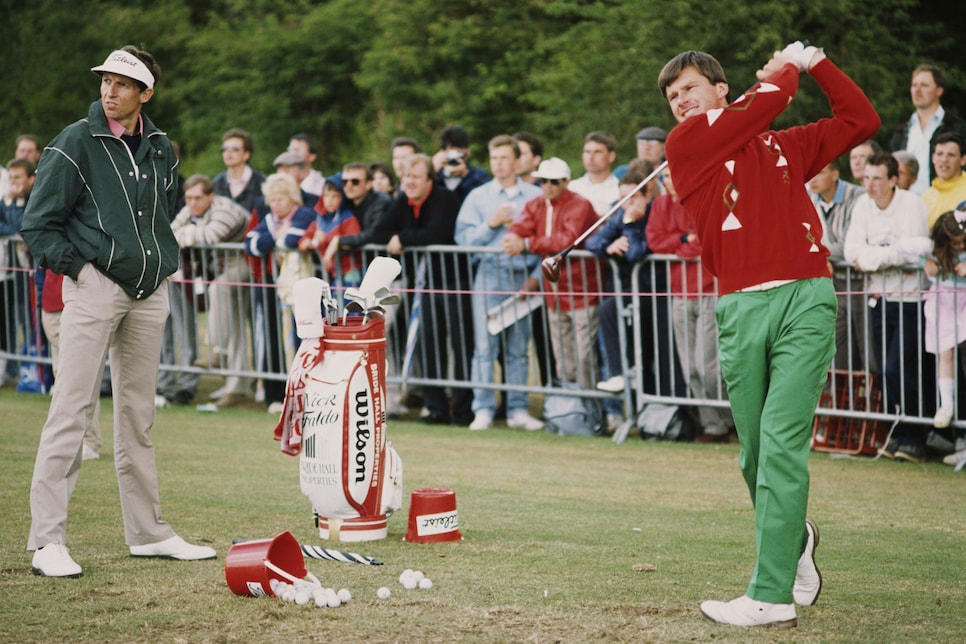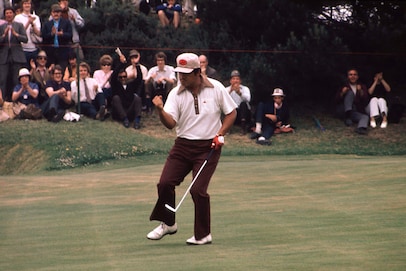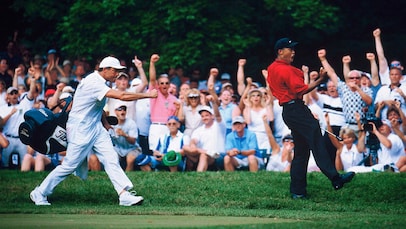The Best I Ever Did
The Best I Ever Did: David Leadbetter

Editor’s note: In celebration of Golf Digest’s 75th Anniversary, each month Writer-At-Large Jaime Diaz will interview key figures in the game to explore what happened when they were at the height of their powers. In June 1985, instructor David Leadbetter teamed with Nick Faldo. Faldo willingly suffered through a difficult transition period that threatened to derail his career. But under Leadbetter’s steady guidance, the fiercely determined Faldo won the 1987 Open Championship and then five more majors. The success of the pair’s intensive synergy and willingness to risk dramatic changes revolutionized the player/coach relationship. To date, Leadbetter students have won 25 majors in the men’s and women’s game. The master instructor considers his contribution to the first as the most significant moment of his career.
As a young man, David Leadbetter wanted to be a touring pro in just about the worst way.
An obsessive reader of golf books and magazines, Leadbetter by his late teens was steeped in the swing technique of every great player and well-versed in the theories of all the top teachers. As he set out on South Africa’s Sunshine Circuit, ostensibly loaded with difference-making knowledge, he became that doomed stock character of the game’s professional minor leagues—the marginally talented perfectionist.
“I knew all about good technique but was never happy with my own,” Leadbetter, 72, now says with a chuckle in his home office in Sarasota, Fla., the shelves filled with his lovingly curated collection of golf books, including the eight he has authored, “so a lot of doubt, a lot of frustration, a lot of negativity. Ripped up many gloves and snapped a few shafts. I needed a sports psychologist before there were any. Probably I wasn’t good enough anyway, but I definitely didn’t have the temperament.”
When he was 24 and his 10-foot birdie putt on the last hole of the 1976 European Tour Q School expired an inch short of the cup, ending an uncharacteristically clutch closing nine of 32 that left him a stroke short of gaining full playing privileges, he decided his competitive career was over. “The best putt I ever missed,” he says.
He turned to teaching. In addition to all the technical knowledge he’d stored up, he’d gained empathy and understanding as a competitor. He discovered he had what his friend J.J. Rivet, a noted expert in athletic movement, would call a “biomechanical eye” that can spot small flaws, inefficiencies and power leaks in a full-speed swing. Whereas tournament golf had come hard for Leadbetter, teaching tournament golfers came easy.
He set up a teaching headquarters at the now-defunct Grenelefe Resort, about 45 miles southwest of Orlando. During the early 1980s, he began coaching Nick Price and Denis Watson, both of whom had grown up with Leadbetter in Zimbabwe. The three would stay at Leadbetter’s condo, located hard against the practice range, and use the training-camp environment for intense practice sessions to further improve their ball-striking. In 1983, Price won his first PGA Tour title, and in 1984, Watson would win his first three.
Nick Faldo, desperate for improvement, took notice. The Englishman had been an emerging star, who in 1983 had won five times on the European Tour to earn the Order of Merit and then won on the PGA Tour in 1984. He also had a Ryder Cup record of 11-4-0. Faldo, though, had fallen short while in Sunday contention of two majors, the 1983 Open and the 1984 Masters, prompting the tabloid tag of “El Foldo.” The failures convinced Faldo that his willowy golf swing was not built to hold up to the demands of a major championship. Knowing that Mark O’Meara and Hank Haney had recently collaborated on a successful swing change, Faldo found the amiable and rangy Leadbetter wielding his VHS recorder on the practice range at the 1985 Memorial Tournament.
“I had shared some of my ideas with Nick the previous December, but now he was very forthright and direct,” Leadbetter remembers. “He said, ‘I know what I’ve got is not good enough to be the best.’ He wanted to win majors. He wanted to be No. 1, and he wanted me to help him.
“I told him we would be doing some things that were radically different from what he’d been doing and that he would probably go backward before he went forward. I estimated it would take about two years. Nick said, ‘Fine. I want you to throw the book at me.’ You don’t often get someone like that, so I didn’t have any qualms. It was an honor.”
The failures convinced Faldo that his willowy golf swing was not built to hold up to the demands of a major championship.
In two years and a month, Faldo would win the Open Championship, his first of six majors, at Muirfield.
“We were two driven people whose strengths complimented each other, seeking a shared vision, knowing we were doing something new and exciting,” Leadbetter says. “There was so much energy, chemistry and karma involved, it almost didn’t matter what the obstacles were, we were going to be successful.”
The foundation for that work was laid in early childhood before Leadbetter ever heard of golf. A serious asthmatic condition marked by persistent labored breathing caused his sternum to protrude. “It was a bit of a trauma with the other kids,” he says. “It probably made me a little bit of the outsider, always observing and analyzing.”
In part to find a better climate for David, the family of six moved from southern England to what was then Rhodesia (now Zimbabwe) when Leadbetter was 7. He became “mad keen” about sports, excelling at cricket and tennis. By his early teens, golf became his passion.
Achievement ran in the family. Leadbetter’s father, Douglas, had been a decorated World War II bomber pilot, flying missions over Rommel’s army in northern Africa. Young David was most drawn to the stories about his maternal grandfather, George Thomas. After being blinded by a bullet during the Battle of the Somme in World War I, Thomas became one of Britain’s leading osteopaths.
“After he learned the curriculum by Braille, he developed a reputation for having an amazing sense of touch and feel in his hands,” Leadbetter says. “Patients would come from all over Europe to see him. I connected to his gift because early on I knew I had this ability, whether naturally or through watching sports and becoming obsessed, to be able to see flaws in athletic motion and understand how it could be corrected. That has never been difficult for me.”
Leadbetter knew exactly why Faldo had been dissatisfied with a ball flight that launched too high with too much spin, lacking control in the wind.
“Nick had the classic swing of the '60s and '70s—very upright with high hands at the top, big hip slide starting down, big reverse-C finish,” Leadbetter says. “It created a steep angle of attack that could cause the ball to balloon. There was a lot of timing needed, which was one reason Nick never varied his superb rhythm, but the hands often had to do a lot of work, making it a hard swing to repeat in pressure situations.”

JUST DO THAT: At Wentworth in 1989, when Faldo was European Tour Golfer of the Year.
Getty Images
Owing to his intense study of the swings of Hogan and Snead, in the 1980s Leadbetter was influential in moving the teaching community away from the reverse-C swing and toward an awareness that the rotation of the trunk, and not the driving of the legs, was the most efficient source of power and stability in the golf swing. Accordingly, he guided Faldo into a more rounded motion in the backswing by having him turn his left forearm clockwise along a flatter plane while pivoting more deeply into a flexed right leg. In the downswing, initiating the transition with a turning rather than the sliding of the hips shallowed the plane into impact. The former reverse-C finish was transformed into one marked by a straighter body and a lower arm follow-through.
The result was a lower, more penetrating ball flight that was easier to control and allowed more shot-making versatility. With the rotational big muscles allowing the hands to be more passive, Faldo’s swing would be less timing reliant and more resistant to pressure. It was a swing built more for precision than power and so was especially suited to iron play. “Major championships test iron play more than any part of the game,” Leadbetter says. “Every great player has been a great iron player. Nick became one of the best ever.”
When Faldo and Leadbetter began working together in June 1985 in the Central Florida heat at Grenelefe, the soon-to-be 28-year-old Faldo would hit more than a 1,000 balls a day.
“He was relentless,” Leadbetter says. “When I spent a week with Nick, I was mentally tired but also exhilarated. He was a perfect student. He had learned the new movements pretty quickly. Of course, they hadn’t been embedded in tournament play, which is the hard part that takes time.”
There were legions of British doubters who feared their young hero would lose his way with this obscure guru. They gained more ammunition as the year went on, as Faldo finished at the bottom of the field in stroke-play events, including a T-53 at the Open, and then was forced into the lion’s mouth at the Ryder Cup at the Belfry. Faldo was expected to be a stalwart on a European team vying to win for the first time since 1957, but with the swing changes he simply wasn’t ready for such a pressurized arena. After playing poorly while paired with Bernhard Langer, Faldo asked captain Tony Jacklin to keep him out until the singles, which he would also lose. The roasting he and Leadbetter received would have been worse but for Team Europe winning.
“When I spent a week with Nick, I was tired but also exhilarated. He was the perfect student.”
“That was too much, too soon, and Nick was exposed,” Leadbetter says. “The thought crossed my mind that if he was ever going to quit this project, this was the time. But he kept looking big picture and never had a questioning word, which increased my confidence that something very good was going to come of this.”
Yet 1986 was another long year, highlighted only by a fifth-place finish at the Open at Turnberry. Faldo increased his intensity, diligently following Leadbetter’s encouragement of constantly repeated swing drills.
“Nick is very much a feel player, contrary to how he is perceived,” Leadbetter says. “He did the drills because he understood that they reinforce an exaggerated feel that you can keep within yourself and repeat. It’s that feel, not thought, that you rely on in competition.”
There was no ignoring the ticking clock as Faldo’s contemporaries, Sandy Lyle, Langer and Greg Norman, all won their first majors. Faldo’s steady run of poor finishes also cost him sponsors. “Outwardly at least, it was like he really didn’t care,” remembers Leadbetter. “He just set that claret jug as his holy grail, and that was it.”
As Faldo told Guy Yocom in 2006, there was more. “I’ve kept much of that experience to myself. It was dark, intense and sometimes negative, wondering when the changes were going to take—and if they would take.” In 1987, they did. “Everything finally became less conscious,” Leadbetter says.
A turning point was at the Magnolia State Classic in Hattiesburg, Miss., the opposite-field event the week of the Masters, which Faldo was not invited to for the second year in a row. “I could sense that Nick was uptight about missing Augusta. Without really thinking the last thing I said to him was, ‘soften your arms.’ With that thought, he went and shot four 67s and finished second. It was a breakthrough feeling for Nick that he carried right through Muirfield, something I said purely on instinct.”
In May, Faldo won the Spain Open, his first victory in three years, on a course set up by Seve Ballesteros to approximate major-championship conditions. It was a positive signal to Faldo that his game had a new dimension.
The Open at Muirfield would be Faldo’s first major of the year, but Leadbetter had to stay in the U.S. Before the championship he told Faldo, “You’re ready.”
“In retrospect, it was almost ideal,” says Leadbetter of the week that Faldo turned 30. “By my not being there, Nick had to take off the training wheels, and that’s when he really owned the changes he had made. That final round of 18 pars, that penetrating 5-iron approach on the last hole, held up. Muirfield was the giant step for both of us.”
For all the great players that Leadbetter coached over more than four decades, he never had another whose perfectionism so thoroughly matched his own.



/Lead fairway bunker.png.rend.hgtvcom.406.271.suffix/1720443545447.png)
